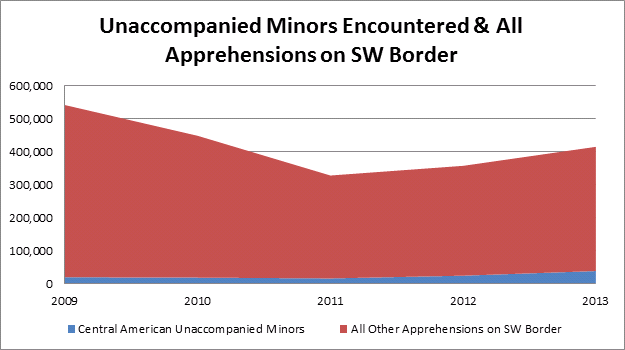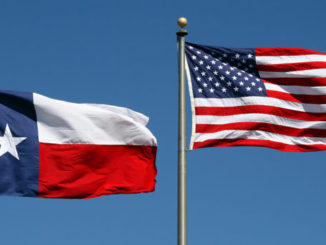
By Alex Nowrasteh
Over the last few weeks, the media has been abuzz with stories of unaccompanied minors coming across the border and being apprehended by Customs and Border Protections (CBP). Many of the facts on the ground are fuzzy because we do not have a complete picture of all of the relevant data. In this post I will lay out several of the relevant facts as they exist. I will present information that focuses on how the detention facilities are overwhelmed but that it is less likely that border patrol agents on the border are actually overwhelmed.
Background
The unlawful immigration of minors is not a new phenomenon, although it has increased recently. CBP released this table showing the large increase in the number of unaccompanied minors that have been encountered (different from “apprehended”):
| Country | Fiscal Year 2009 | Fiscal Year 2010 | Fiscal Year 2011 | Fiscal Year 2012 | Fiscal Year 2013 | Fiscal Year 2014 |
| El Salvador | 1,221 | 1,910 | 1,394 | 3,314 | 5,990 | 9,850 |
| Guatemala | 1,115 | 1,517 | 1,565 | 3,835 | 8,068 | 11,479 |
| Honduras | 968 | 1,017 | 974 | 2,997 | 6,747 | 13,282 |
| Mexico | 16,114 | 13,724 | 11,768 | 13,974 | 17,240 | 11,577 |
| Total: | 19,418 | 18,168 | 15,701 | 24,120 | 38,045 | 46,188 |
Source: http://www.cbp.gov/newsroom/stats/southwest-border-unaccompanied-children
The government has not released data for the total number of unauthorized immigrants encountered or apprehended so far in 2014. As a result, I have to use 2013 data to see how big of an addition unaccompanied minors made to apprehensions of unlawful immigrants in that year. Encounters and apprehensions are not synonymous in Border Patrol statistics but they are close enough for a back of the envelope calculation.
In 2013, Central American children encounters as percent of total apprehensions on the southwest border were relatively small:
Source: http://www.cbp.gov/sites/default/files/documents/U.S.%20Border%20Patrol%20Fiscal%20Year%20Apprehension%20Statistics%201960-2013.pdf and http://www.cbp.gov/newsroom/stats/southwest-border-unaccompanied-children
That is in contrast to the usual graph you see of the increase in unaccompanied minors (below). The blue on the following graph, except for 2014, is the blue in the above graph.

Source: http://www.cbp.gov/newsroom/stats/southwest-border-unaccompanied-children
In 2013, only 6 percent of all apprehensions on the southwest border were unaccompanied minors:

Source: http://www.cbp.gov/newsroom/stats/southwest-border-unaccompanied-children and http://www.cbp.gov/sites/default/files/documents/U.S.%20Border%20Patrol%20Fiscal%20Year%20Apprehension%20Statistics%201960-2013.pdf
CBP divides the border in sectors. Many of the unaccompanied minors crossing into the United States are concentrated in specific sectors – like the Rio Grande sector. The 2014 data on the total number of apprehensions per border sector are not available although the government has released the data on the number of unaccompanied minors apprehended per border sector. Here are the numbers from 2013 and so far in 2014:
| Sector | Fiscal Year 2013 | Fiscal Year 2014 | % Change |
| Big Bend Sector | 99 | 148 | 49% |
| Del Rio Sector | 1,396 | 2,401 | 72% |
| El Centro Sector | 304 | 411 | 35% |
| El Paso Sector | 534 | 682 | 28% |
| Laredo Sector | 2,496 | 2,745 | 10% |
| Rio Grande Sector | 12,484 | 33,470 | 168% |
| San Diego Sector | 414 | 642 | 55% |
| Tucson Sector | 6,569 | 6,254 | -5% |
| Yuma Sector | 197 | 264 | 34% |
| Southwest Border Total | 24,493 | 47,017 | 92% |
Source: http://www.cbp.gov/newsroom/stats/southwest-border-unaccompanied-children
The Rio Grande sector has seen the greatest number of unaccompanied minors trying to cross. In 2013, 12,484 unaccompanied minors were apprehended in that sector. So far in 2014, the number has risen to 33,470 – a 168 percent increase over last year, and fiscal year 2014 isn’t over yet.

Source: http://www.cbp.gov/newsroom/stats/southwest-border-unaccompanied-children
By the end of the year the numbers should increase even further. But compared to historical crossings in the Rio Grande Valley, the total numbers in 2013 are not unprecedented. We have to wait for the 2014 numbers for all apprehensions per border sector to understand how the recent surge in unauthorized immigrants compares to past increases. Historically, border patrol in the Rio Grande Valley has apprehended more unauthorized immigrants in the past with far fewer border patrol agents.

Border Patrol Overwhelmed? Yes and no.
Consistent statements from CBP assert that they are overwhelmed by the recent influx of unaccompanied minors. Detention facilities are certainly overflowing – partly because of the government’s increased border enforcement over the last 10 years. However, the number of Border Patrol agents on the southwest border has never been greater:
The number of Border Patrol apprehensions on the southwest border has also decreased over time, mainly because of a decrease in the number of unlawful immigrants attempting to enter.

In 2013, each border patrol agent apprehended 22.3 unlawful immigrants, on average. This is compared to 1993, when each border patrol agent on average apprehended 352.2 unlawful immigrants. Many government apprehension facilities are overwhelmed but it is a stretch to state that the largest border patrol in U.S. history, with fewer apprehensions per agent in 2013 than almost any previous year, is suddenly overwhelmed.

The real bottleneck is in detention facilities, not the numbers of border patrol agents on the ground. As the New York Times reported:
“While the Obama administration has moved aggressively to deport adults, it has in fact expelled far fewer children than in the past. Largely because of a 2008 federal law aimed at protecting trafficked children, the administration in 2013 deported one-fifth the number of Central American children as were expelled in 2008, according to federal government statistics.”
The 2008 act, the William Wilberforce Trafficking Victims Protection Reauthorization Act (TVPRA) of 2008, forced U.S. official to inquire into the vulnerability of unaccompanied minors to trafficking and other forms of abuse. U.S. officials were then only allowed to deport the children quickly if they make a voluntary decision to return. Longer processing times created by the 2008 act mean longer wait times for the minors in immigration detention facilities. As a result, crowding has occurred and the overflow has been moved to military bases. The short-term solution is not to further deprive these children of their rights by deporting them without due process but to release them quickly into the care of their resident American families or American non-profits charged with their care. In the long term, cheaper and more streamlined family reunification policies should be implemented to move otherwise peaceful and healthy children out of detention as fast as possible.
Few unaccompanied minors have been incentivized to come because of the legal change because, as Dara Lind at Vox noted, few unaccompanied minors even knew about it. The TVPRA caused a bureaucratic backlog, thus making the immigration enforcement system less capable of handling a sudden increase in unaccompanied minors. The agents on the ground are not overwhelmed, bureaucratic ossification has created a bottleneck in the processing and detention apparatus. In a future post, I will analyze the various theories explaining why there has been a sudden increase in the immigration of unaccompanied minors.
Alex Nowrasteh is the immigration policy analyst at the Cato Institute’s Center for Global Liberty and Prosperity.





